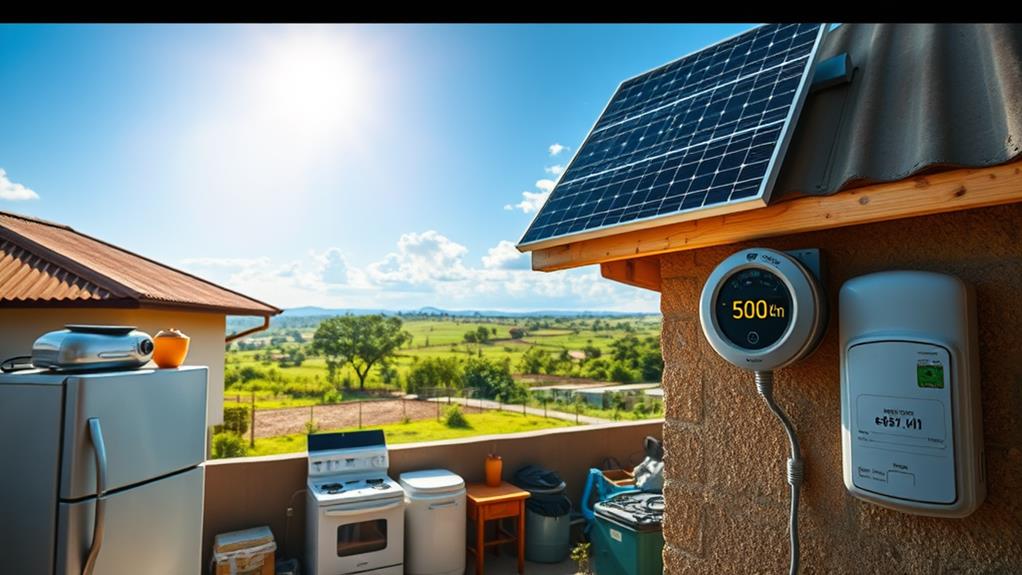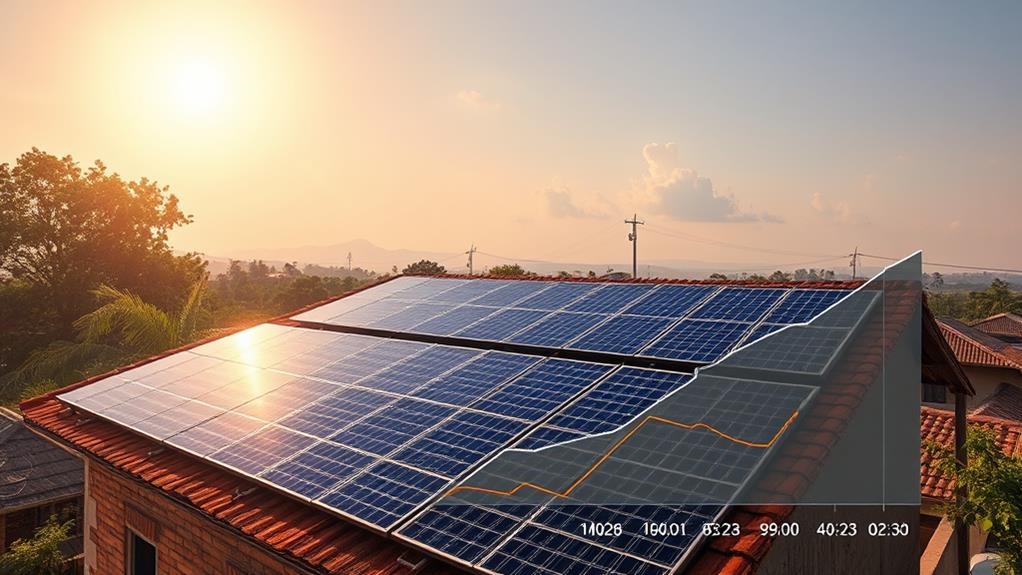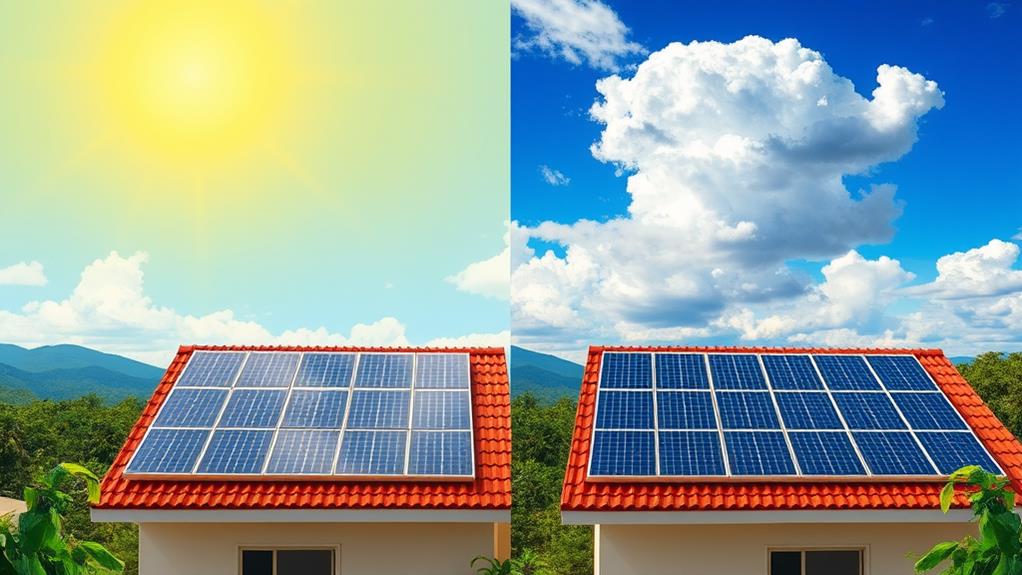Did you know that Kenya's average solar irradiance is one of the highest in the world at around 5.5 kWh/m² per day? This makes it an ideal location for solar energy. If you're looking to generate 500 kWh per month, you might need around 10 to 12 solar panels, but several factors could influence this estimate. Panel efficiency, local weather patterns, and seasonal variations all play a role in determining your exact requirements. So, how do you accurately calculate the number of panels needed for maximum energy independence in Kenya? Let's break it down step-by-step.
Understanding Your Energy Needs

To effectively plan for solar panels that generate 500 kWh per month in Kenya, understanding your energy needs becomes crucial.
Begin by auditing your household appliances and their energy consumption. Calculate the monthly usage of high-consumption devices like refrigerators, air conditioners, and washing machines. Note how often you use each appliance, as this directly impacts your total energy consumption.
For instance, a refrigerator running 24/7 can consume around 100 kWh per month, whereas an air conditioner used intermittently might add another 150 kWh. Compile a detailed list, including smaller devices like lights, laptops, and fans. Each item contributes to the overall energy requirement, which helps you gauge the solar capacity needed.
It's also important to evaluate the types of solar energy available, as different systems may offer varying efficiencies and benefits based on your specific usage patterns.
Once you've identified the consumption patterns, sum up the monthly kWh usage. If your total exceeds 500 kWh, explore energy-efficient alternatives or reducing use.
It's crucial to match your energy profile with your solar panel system to guarantee peak performance and self-sufficiency. This detailed understanding empowers you to make informed decisions, aligning with your goal of achieving energy independence and maximizing the benefits of solar power in Kenya.
Kenya's Solar Potential
Kenya's solar potential is immense, thanks to its geographic location near the equator, which provides an average of 4 to 6 peak sunlight hours per day. This abundant sunlight makes solar energy a highly viable option for meeting your energy needs. By harnessing this renewable resource, you can achieve energy independence and contribute to a sustainable future.
In technical terms, Kenya's high insolation levels translate to significant daily solar radiation, measured in kilowatt-hours per square meter (kWh/m²). This metric is vital for calculating how much solar energy you can capture and convert into electricity. Peak sunlight hours directly impact the efficiency and output of your solar panels, making Kenya one of the best locations globally for solar installations.
Additionally, leveraging photovoltaic systems can further maximize the energy conversion potential.
Moreover, the country's solar energy sector is rapidly growing, driven by both governmental support and private investments. By investing in solar panels, you're not just tapping into a renewable resource; you're also gaining autonomy from the often unreliable national grid.
Embracing solar energy in Kenya isn't just a technical decision; it's a step towards freedom and self-sufficiency. With the right setup, you can efficiently meet your energy needs and support a renewable future.
Calculating Solar Panel Output

To determine how many solar panels you need, start by considering Kenya's average sunlight hours, which typically range between 4 to 6 hours per day.
The transformative potential of solar energy can greatly impact individual and community energy usage.
Next, factor in the panel efficiency rate, which indicates how effectively panels convert sunlight into electricity.
Average Sunlight Hours
Understanding average sunlight hours is essential for calculating the output of solar panels in Kenya. You need to take into account solar insolation factors, which refer to the amount of solar radiation received per unit area.
In Kenya, solar insolation is generally high, ranging from 4 to 6 peak sun hours per day depending on the location and time of year. These peak sun hours are critical as they indicate the number of hours per day that solar panels will operate at full capacity.
Seasonal variations also play a significant role. During the dry season, you'll benefit from more consistent sunlight, whereas the rainy season might reduce the effective sunlight hours.
In Nairobi, for instance, you can expect around 5 peak sun hours on average, which fluctuates slightly throughout the year.
To calculate your solar panel output, multiply the average daily peak sun hours by the panel's wattage. If you're aiming for 500 Kwh per month, divide your monthly requirement by the average peak sun hours, then by 30 days.
This will give you a clearer picture of how many panels you'll need, accounting for Kenya's unique solar insolation factors and seasonal variations. Accurate data guarantees you maximize your energy independence and make the most of Kenya's abundant sunlight.
Panel Efficiency Rate
Considering the average sunlight hours, the next step involves understanding the panel efficiency rate to accurately calculate solar panel output. Different solar panel types, such as monocrystalline, polycrystalline, and thin-film, come with varying efficiency ratings.
Monocrystalline panels, known for their high efficiency, typically convert around 15-20% of sunlight into electricity. Polycrystalline panels, slightly less efficient, range from 13-16%, while thin-film panels lag behind with efficiency ratings between 7-13%.
To determine how many solar panels you need, you must first calculate the energy production per panel. Assume you're using monocrystalline panels with a 20% efficiency rating. In Kenya, with an average of 5 peak sunlight hours per day, each 300-watt panel would produce about 1.5 kWh daily (300W x 5 hours x 0.20 efficiency).
Over a month, that's roughly 45 kWh. Now, divide your monthly energy requirement (500 kWh) by the monthly production per panel (45 kWh). You'd need approximately 12 panels (500 kWh / 45 kWh per panel).
Energy Loss Factors
When calculating solar panel output, you can't ignore energy loss factors, which greatly impact the system's overall efficiency. These losses stem from various sources, each affecting the energy you can harness from your panels.
Dust, dirt, and bird droppings can accumulate on the surface, reducing sunlight absorption. Regular cleaning, a key maintenance consideration, mitigates this issue but requires time and effort.
Temperature fluctuations also play an important role. Solar panels operate less efficiently in extreme heat, so understanding Kenya's climate and selecting panels designed for such conditions helps optimize output.
Additionally, shading from trees or buildings greatly reduces the energy generated. Proper placement and periodic trimming of vegetation are essential.
Over time, solar panel lifespan influences efficiency too. Panels degrade gradually, often losing around 0.5% of efficiency per year. By the end of their 25-year lifespan, they'll produce considerably less energy than when new.
Monitoring and replacing aging panels guarantee consistent energy output.
Panel Efficiency Rates
Maximizing energy output hinges on the efficiency rates of the solar panels you choose. Solar technology has seen rapid advancements, offering various panel types with differing efficiencies. For instance, modern panels achieve efficiencies between 15% and 22%, considerably improving energy output.
Generally, monocrystalline panels are the most efficient, converting around 15-20% of sunlight into electricity. Polycrystalline panels, although slightly less efficient, still offer a reliable option, converting about 13-16% of sunlight. Thin-film panels lag, with efficiencies ranging from 7-10%, but their flexibility can be advantageous in specific installations.
When calculating the number of panels needed to generate 500 kWh per month, you'll want to focus on the efficiency rate as a critical factor. Higher efficiency means fewer panels for the same energy output. For instance, if you opt for monocrystalline panels, you'll need fewer of them compared to using polycrystalline or thin-film types. This not only saves space but also potentially reduces installation costs.
Consider that efficiency rates aren't static; they can be influenced by factors like temperature and shading. So, choosing high-efficiency panels provides a buffer against these variables, ensuring a more consistent energy yield.
Selecting the right panel type tailored to your specific needs and conditions will maximize your energy freedom.
Impact of Weather Conditions

You need to contemplate how Kenya's rainy season can decrease solar panel output by reducing sunlight exposure.
On average, the country experiences about 4-6 sunlight hours per day, which directly influences energy generation.
Additionally, higher temperatures can reduce panel efficiency, as excessive heat can limit the photovoltaic cells' performance.
Rainy Season Impact
The rainy season in Kenya greatly affects solar panel efficiency, primarily due to the reduction in sunlight hours and increased cloud cover.
During these periods, the amount of solar energy that your panels can harness decreases considerably. This has a direct impact on your ability to generate the 500 kWh per month that you're aiming for.
To manage this, consider the following technical factors:
- Panel Type: High-efficiency panels like monocrystalline types perform better under low-light conditions compared to polycrystalline panels.
- Angle of Installation: Adjusting the tilt of your panels can maximize exposure to available sunlight, even during cloudy days.
- Energy Storage: Invest in high-capacity batteries to store excess energy generated during sunnier periods, which can be used during the rainy season.
- System Monitoring: Implement a robust monitoring system to track energy production and consumption, enabling timely adjustments to optimize solar efficiency.
Average Sunlight Hours
Kenya's average sunlight hours fluctuate considerably due to varying weather conditions throughout the year. You must consider these fluctuations when determining the number of solar panels needed for 500 kWh per month.
Typically, Kenya enjoys between 4 to 6 peak sunlight hours daily, but these can vary based on geographic variations. Regions like Nairobi might experience less solar radiation during the rainy season, while arid areas like Turkana usually benefit from more consistent sunlight.
To calculate your solar panel requirements accurately, you should analyze historical weather data for your specific location. In areas with high solar radiation, fewer panels might suffice, whereas regions with frequent cloud cover will necessitate more panels to compensate for reduced sunlight.
This variability means you need to tailor your solar setup to your specific geographic conditions.
Temperature Effects on Efficiency
When considering solar panel efficiency, temperature plays an important role. You might assume more heat means better performance, but it's not that straightforward. High temperatures can actually reduce the efficiency of solar panels. In Kenya, where temperature fluctuations can be quite significant, understanding this impact is vital for maximizing your energy output.
- Temperature Coefficient: Each solar panel has a temperature coefficient, typically ranging from -0.2% to -0.5% per degree Celsius. This means for every degree above 25°C, your panel's efficiency decreases by this percentage.
- Heat Management: Effective heat management is important. Elevated temperatures can cause solar cells to overheat, reducing their operational efficiency. Installing panels with proper ventilation helps maintain ideal temperatures.
- Material Selection: Some materials handle heat better than others. Monocrystalline silicon panels generally perform better under high temperatures compared to polycrystalline panels, making them a more efficient choice in regions with high temperature fluctuations.
- Installation Angle: The angle at which you install your solar panels can also influence heat dissipation. A steeper angle can facilitate better airflow around the panels, aiding in cooling and consequently maintaining efficiency.
Estimating Total Panels Needed
To accurately determine the number of solar panels you'll need to generate 500 kWh per month in Kenya, it's essential to understand several key factors.
First, you need to take into account the efficiency of different solar panel types. Monocrystalline panels typically offer higher efficiency and performance in limited space, while polycrystalline panels are a bit cheaper but less efficient. Additionally, portable solar panels can offer flexibility for various applications, especially in remote areas.
Next, you should account for Kenya's average solar irradiance, which is around 5.5 kWh/m²/day. This figure helps you estimate the energy each panel can generate daily. For instance, a standard 300-watt panel can produce about 1.65 kWh per day under ideal conditions.
To meet your monthly target of 500 kWh, you'd divide 500 by 30 (days), resulting in approximately 16.67 kWh/day. Then, divide 16.67 by 1.65, giving you roughly 10.1 panels.
Don't forget to factor in installation costs. These can vary based on the complexity of your setup and the quality of materials used.
While upfront costs might be substantial, the long-term savings and energy independence you'll gain make it a worthwhile investment.
Conclusion
To meet your 500 kWh monthly energy needs in Kenya, you'll need roughly 10 to 12 solar panels. Curiously, with Kenya's average solar irradiance of 5.5 kWh/m² per day, a single 300-watt panel generates about 1.65 kWh daily. Factoring in local conditions and potential energy losses, this setup guarantees peak performance and energy independence. By understanding these specifics, you can make informed decisions about your solar investment and maximize efficiency.
